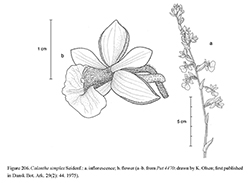e-Flora of Thailand
Volume 12 > Part 2 > Year 2014 > Page 369 > Orchidaceae > Calanthe
19. Calanthe simplex Seidenf.wfo-0000765240
Dansk Bot. Ark. 29(2): 42, fig. 16a–b. 1975; S.C.Chen et al. in Z. Wu et al. (eds), Fl. China 25: 299. 2009; Kurzweil, Adansonia, sér. 3, 32: 82. 2010; D.A.Clayton & P.J.Cribb, Gen. Calanthe: 41, fig. 9.8. 2013. Fig. 206; Plate XXIX: 3.
Accepted Name : This is currently accepted.
Description : Flowering shoots 40–55(–94) cm tall. Pseudobulbs insignificant, hidden by the bases of the foliage leaves, 4.5–8.5 by 1–1.5 cm. Foliage leaves 2–3, lanceolate-oblong, acute or acuminate, perennial, glabrous, 20–60 by 3.2–10.5 cm; petioles 7–15 cm long. Inflorescences lax, dull dark violet, hirsute; peduncles 30–36(–75) cm long; sterile bracts 4–6, lanceolate-oblong, acute, 1.9–4.1 cm long; rachis 10–19 cm long, 12- to 30-flowered; floral bracts ovate-lanceolate, acute or acuminate, persistent, 15–23 by 3.5–6 mm. Flowers yellow-green; hirsute on the outside of the perianth. Sepals ovate-lanceolate, shortly acuminate, 8–14 by 5–7.8 mm. Petals obovate-elliptic, spathulate, 8–12 by 3.5–5.3 mm. Labellum unlobed, broadly reniform, base extensively fused with the sides of the column, 10–15 by 8–16 mm, apically sometimes irregularly lobed and emarginate; ornaments of 3 basal keels; spur cylindric, sparsely hairy, 8–12.5 mm long. Column densely hirsute, 4–8 mm long. Ovary 6–9 mm long, distinct from the 5–9 mm long pedicel; both parts pubescent, light green and violet-tinged. Capsule not seen.
Thailand : NORTHERN: Chiang Mai (Doi Chiang Dao – type: Put 4470, holotype -K).
Distribution : SW China (Yunnan).
Ecology : Terrestrial in open limestone terrain in savanna or forests; 1,700–2,000 m alt. Flowering: November–December.
Vernacular : Ueang nam ton chiang dao (เอื้องน้ำต้นเชียงดาว)(Chiang Mai).
Notes: Following the original suggestion of Seidenfaden (1975) the species was placed in subgenus Preptanthe by Clayton & Cribb (2013), mainly based on the general appearance of the hairy inflorescence and the flowering in the dry season. However, Kurzweil (2010: 83) argued that this species does not seem correctly placed in this subgenus because of its vegetative features.


